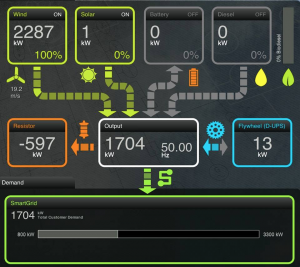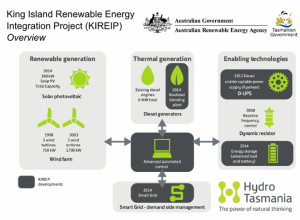Hydro Tasmania’s renewable energy integration project on King Island, which aims to displace the use of diesel fuel by using a combination of renewable and enabling technologies, has managed to meet King Island’s power needs with 100% continuous renewable energy for almost 33 hours.

This is the second milestone achievement for King Island Renewable Energy Integration Project (KIREIP) in just a few weeks. Last month, the project delivered an uninterrupted energy supply for a 26-hour period during which diesel generators were completely switched off.
Commenting on the significant milestone, Project Director Simon Gamble said it was the first time anywhere in the world that this has been achieved at a “megawatt scale” for such an extended period of time.
“What makes this significant is that we’ve used renewable energy to support the needs of an entire community, which includes residential and industrial loads, for a full day,” Mr Gamble said.
“Our system has successfully managed the peaks in energy consumption that occur over the course of a full day, including early evening when demand is at its highest and there’s no solar contribution.”

The Australian Renewable Energy Agency (ARENA) CEO Ivor Frischknechtt said the achievement was an example of how different renewable energy and enabling technologies can alleviate the dependence of diesel fuel and provide stable and reliable power “around the clock”.
“Hydro Tasmania is using a unique combination of technologies to reduce King island’s reliance on expensive shipped in diesel and provide residents with a more secure and reliable energy source,” Mr Frischknechtt said.
“This innovative energy solution could benefit off-grid communities on islands and in regional mainland Australia. I look forward to seeing Hydro Tasmania continue to refine and commercialise its approach in other locations.”
Once completed, the $18.25 million King Island project will supply over 65% of King Island’s energy needs and reduce carbon dioxide emissions by more than 95%. ARENA provided $6 million to support the project, and is also supporting Hydro Tasmania to carry out a similar project on Flinders Island.


















